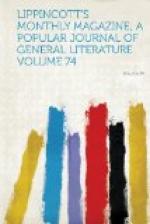[Illustration: Girard avenue bridge—one of the approaches to the exhibition grounds.]
To what point on a continent as broad as the Atlantic were they to come? The European fairs were hampered with no question of locality. That Austria should hold hers at Vienna, France at Paris, and Britain at London, were foregone conclusions. But the United States have a plurality of capitals, political, commercial, historical and State. Washington, measured by house-room and not by magnificent distances, was too small. New York, acting with characteristic haste, had already indulged in an exposition, and it lacked, moreover, the rich cluster of associations that might have hallowed its claims as the “commercial metropolis.” Among the State capitals Boston alone had the needed historical eminence, but, besides the obvious drawback of its situation, its capacity and its commissariat resources, except for a host of disembodied intellects, must prove insufficient. There remained the central city of the past, the seat of the Continental Congress, of the Convention and of the first administrations under the Constitution which it framed—the halfway-house between North and South of the early warriors and statesmen, and the workshop in which the political machinery that has since been industriously filed at home and more or less closely copied abroad was originally forged. Where else could the two ends of the century be so fitly brought together? Here was the Hall of 1776; the other hall that nearly two years earlier received the first assemblage of “that hallowed name that freed the Atlantic;” the modest building in a bed-chamber of which the Declaration of Independence was penned; and other localities rich with memories of the men of our heroic age.
The space of a few blocks covered the council-ground of the Union. Those few acres afforded room enough for the beating of its political heart for twenty-five years, from the embryonic period to that of maturity—from the meeting of a consulting committee of subject colonists to the establishment of unchallenged and symmetrical autonomy.




